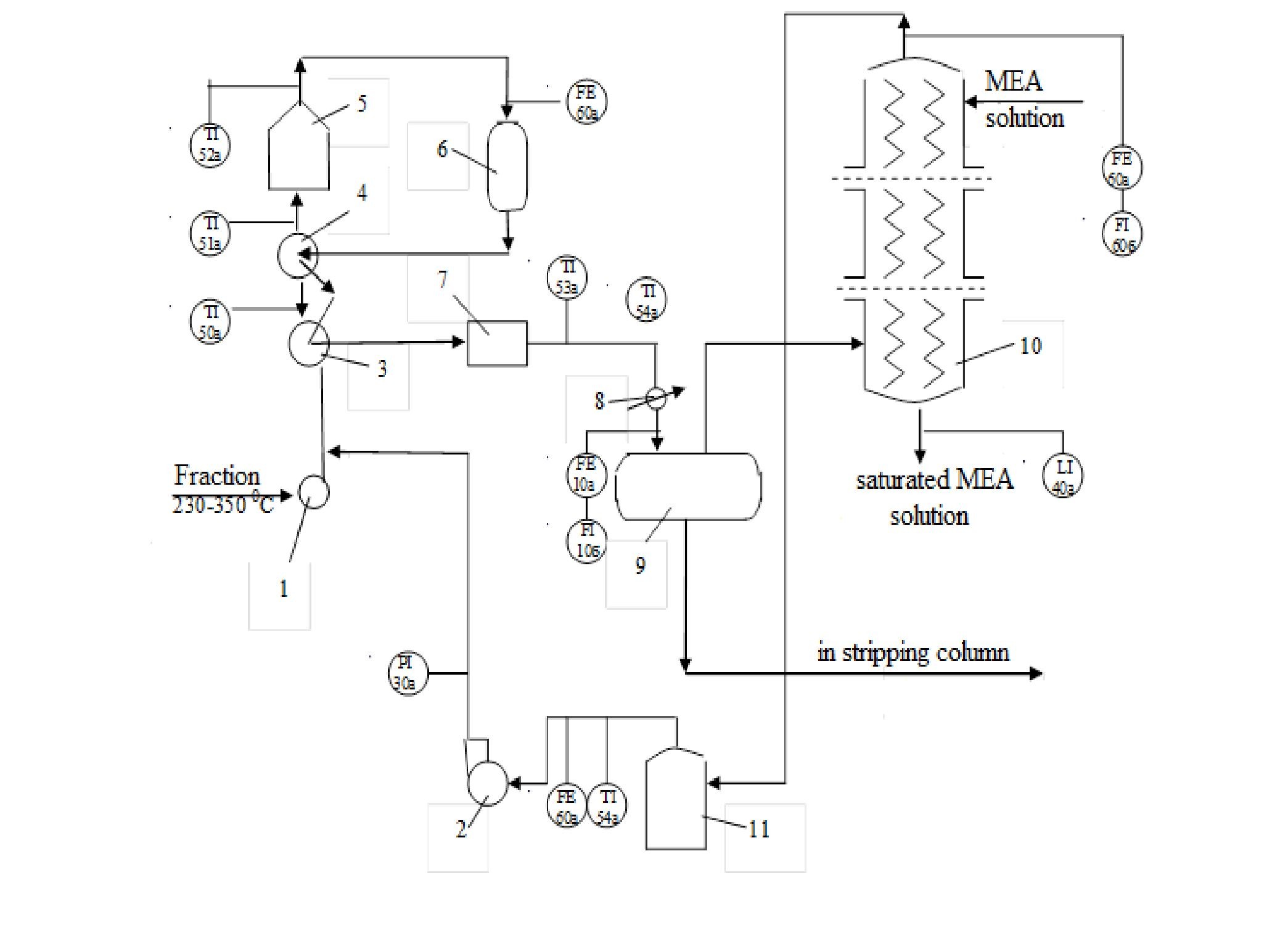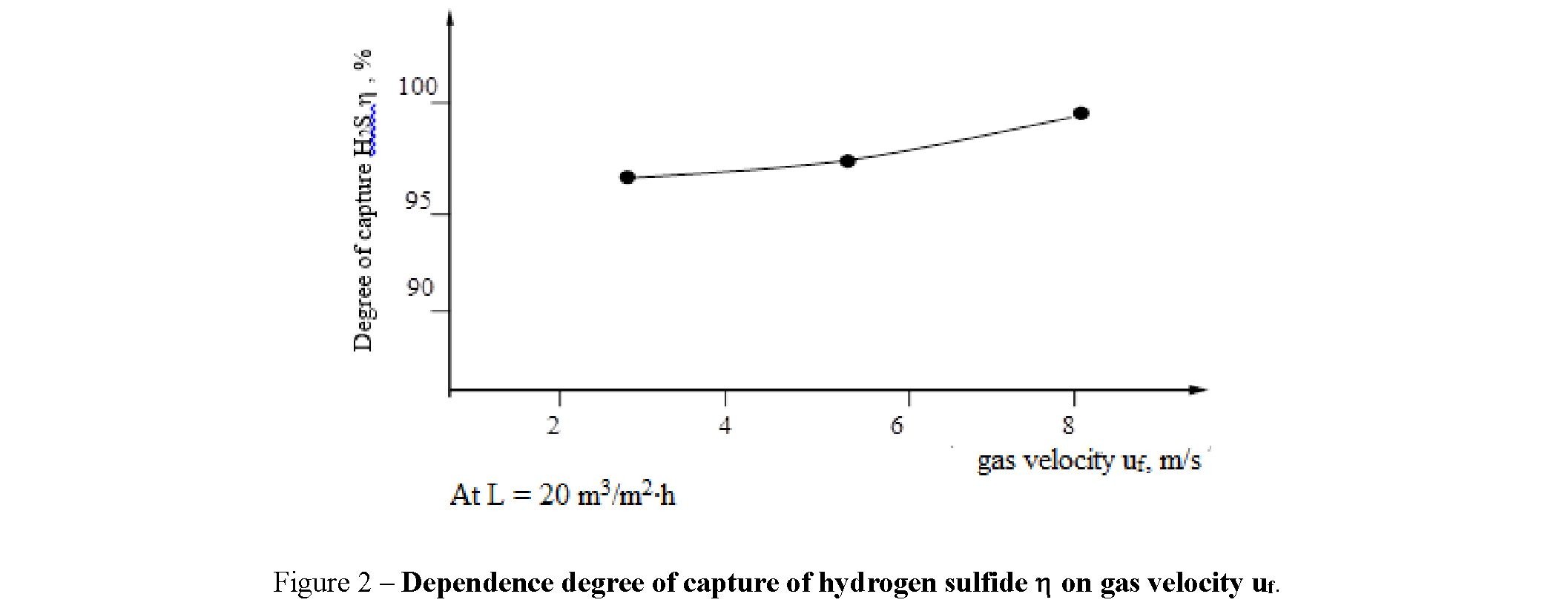Abstract
At the enterprises of pharmaceutical and chemical industries, heat and mass transfer apparatuses operating in gas-liquid system are widely used. The intensification of heat and mass transfer processes in such devices makes it possible to increase productivity of technological devices, reduce their overall dimensions, metal consumption, reduce energy consumption and much more. One of the promising areas of intensification of absorption, also other

types of heat and mass transfer processes is process in swirling flow. The work is devoted to the study of apparatus with rotating flows in industrial environment. The proposed apparatus can be used to purify gas from harmful impurities. The test of this apparatus was carried out under industrial conditions for gas purification from hydrogen sulfide, and high degree of gas purification was obtained.
Key words: apparatus with rotating flows, industrial tests, gas.
The purpose of work is to study efficiency of mass transfer in the apparatus when changing in wide range of operating and design parameters, determining optimal operating mode of apparatus.
Materials and methods. When performing the work, standard and generally accepted research methods were used. Numerical methods of solving differential equations, methods of photographic and chemical analysis of methods for determining hydrodynamic operating modes and mass transfer characteristics of the apparatus.
Results and discussion. Large amount of gaseous hydrogen sulfide is formed at hydro treating diesel fuel. Large volumes of purified gases with high content of sulfur compounds and increased demands on the quality of treatment have led to the desire to find more efficient heat and mass transfer apparatus. Absorbers with cap plates are used to clean circulating hydrogen-containing hydrocarbon gases from sulfur compounds, and regenerated 15% solution of monoethanolamine (MEA) is used as an absorber [1,2].
Absorbers with cap plates along with some advantages have a number of serious disadvantages (narrow range of stable operation, relatively low speed of the gas phase, which leads to significant material and operational costs, etc.). Hydro treating diesel fuel consists of the following stages: mixing diesel fuel with hydrogen-containing gas, hydrogenation of sulfur and nitrogen compounds, purification of hydrogen-containing gas from hydrogen sulfide.
The technological scheme of pilot plant is follows. Raw materials - straight run fraction (250–3500) of diesel fuel - from the atmospheric distillation unit, is received at pump 1 (Fig. 1) and fed to the mixing tee with circulating hydrogen-containing gas coming from centrifugal compressor 2. The gas-feed mixture passes through heat exchangers 3 and 4, where it is heated by the gas-product mixture flow from the reactor, and enters the tube furnace 5. The gas-feed mixture heated to 380–400 °C enters the reactor 6, in which the aluminum – cobalt – molybdenum catalyst hydrogenation of sulfur and nitrogen compounds occurs. The gas-product mixture from the reactor 6 passes through pipe space of the heat exchangers 3 and 4, where it gives off heat to the flow of the gasraw material mixture, and cooled in the air cooler 7 and water before cooler 8. The gas-product mixture cooled to 35–40°C enters the separator 9, where the unstable hydrogenate and circulating hydrogen-containing gas are separated.
32
Figure 1 - Technological scheme of gas purification from hydrogen sulfide
The unstable hydrogenate flows into the stripping column (not shown in the diagram), and the hydrogencontaining gas from the top of separator 9 enters the absorber 10 for purification of hydrogen sulfide with solution of monoethanolamine (MEA). The purified hydrogen-containing gas from absorber 10 through the receiving separator 11 is fed to the compressor 2 and then mixed with raw material. Saturated MEA solution from the bottom of absorber 10 is sent to the MEA regeneration unit.
As an absorber for cleaning gas from harmful impurities, device with rotating flows with 3 sections, each of which has the following geometric parameters, was tested:
height between steps of spiral tape - 0.12 m;
diameter of the holes on spiral tape is 0.01 m;
irrigation system - uniform from above;
apparatus height - 2 m.
The apparatus was equipped with necessary devices for measuring hydraulic resistance of contact zone and flow rates of liquid and gas, and also fittings for sampling for measuring the concentration of H2S.
Pilot tests conducted together with production workers are characterized by the following results:
- concentration of H2S at the inlet of absorber 1.03% (vol.);
- concentration of H2S at the outlet of absorber <0,005% (vol.);
- hydraulic resistance of the contact zone of absorber 800-1000Pa;
- capture efficiency increased to 99.8%.
An assessment was made of the existing absorber with cap plates and absorber with rotating flows according to technical and economic indicators.
The results of pilot tests are shown in Figure 2.
The efficiency of absorption is determined by hydrodynamic situation and depends on physicochemical properties of components captured by absorbent. As result, conditions for necessary efficiency of apparatus are set at known initial and final concentrations of component, number of contact steps and height of gas-liquid layer.
Next, hydrodynamic calculation of apparatus is performed, i.e. choose gas velocity in column and irrigation density, hydraulic resistance of apparatus, the amount of retained liquid, the contact surface of the phases, the mass transfer coefficients in phases.

Conclusion. An analysis of the data obtained during test shows that use of absorber with rotating streams in the capture of H2S has significantly improved the efficiency of apparatus.
The results of pilot industrial test showed promise of using proposed apparatus with rotating flows.
Apparatus with rotating flows are recommended for mass transfer processes.
A pilot test of apparatus with rotating flows for purification of hydrogen-containing hydrocarbon gases from sulfur compounds formed as result of hydrotreatment of diesel fuel.
REFERENCES
- 1. Dulybai E., Orymbetov E.M., Orymbetova G.E. Development of the design of apparatus with rotating flows for biotechnological processes. J.Vestnik of the South-Kazakhstan medical academy. N4(84) Shymkent, 2018. – P.19-20
- 2. Orymbetova G.E. et al. Intensification of heat and mass transfer processes in field of centrifugal forces // Proceedings of ISPC “Chemistry in building materials and materials science in the 21st century”. - Shymkent, 2008. –V.1. - P.176-179.